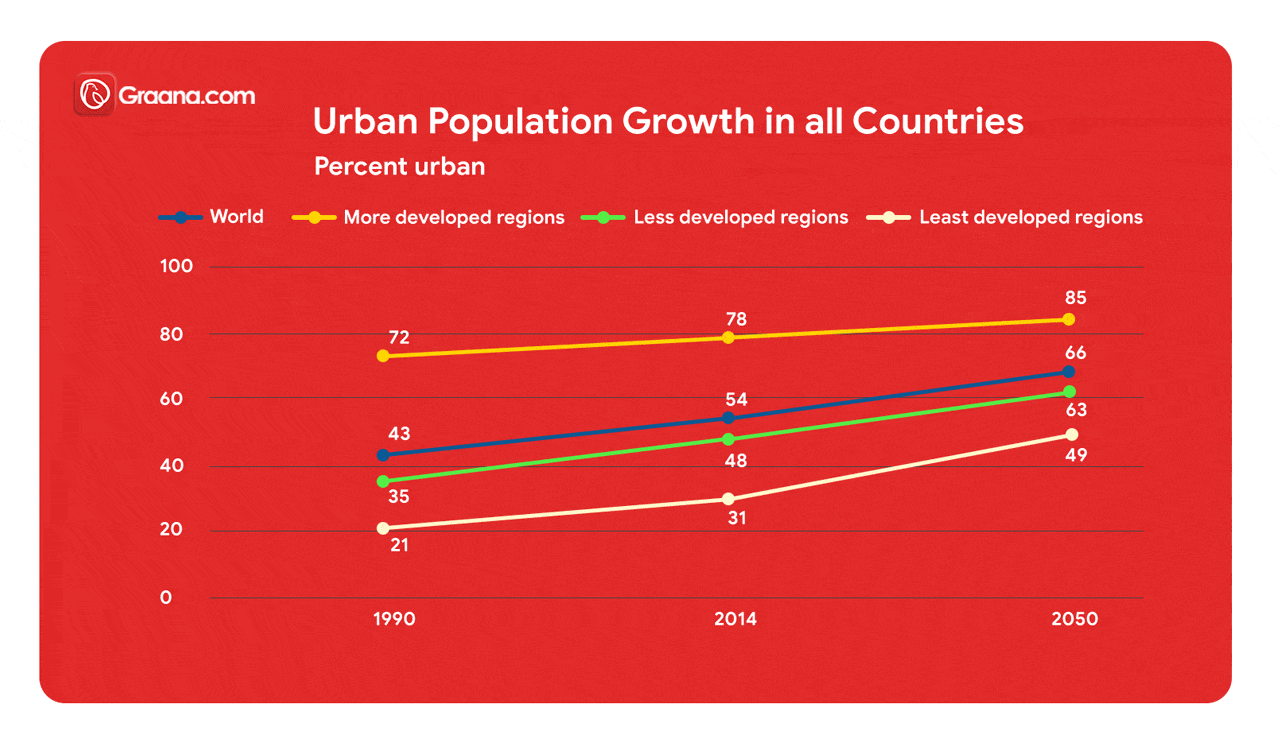By Laila Waqar Towns and cities have become the preferred locations for living. At the start of the 1800s, only… Read More
The post The Challenges and Opportunities of Urbanization appeared first on .
By Laila Waqar
Towns and cities have become the preferred locations for living. At the start of the 1800s, only 2% of the world’s population lived in the cities. Today, around 54% of the population lives in urban areas according to the statistics provided by the World Bank.
This signals exponential growth in urbanization mainly owing to the industrial revolution that encouraged people to migrate to the cities in search of employment.
Graana.com sets forth the challenges and opportunities of urbanization in a move to shed light on the emerging situation.


1. Environmental hazards
Uncontrolled urbanization poses a threat to the environment and sustainability. According to a study, urban centers have half of the world’s land yet their consumption comprises more than three-fourths of its natural resources. This means that the increase in development and ultimately population settlement in developed areas have contributed adversely to the efficient utilization of natural resources.
Similarly, as per the United Nations report of 2011, urban centers contribute to 70% of the harmful greenhouse emissions. Therefore, the increased concentrated use of energy in the urban spaces contributes to air pollution, significantly impacting health. For example, the excessive use of automobiles generates an increased level of lead in the air rendering the air quality harmful for health.
2. Lack of infrastructure
Urbanization and population are growing hand in hand. With an increase in the influx of people moving to the cities, infrastructure is required to maintain the standard of living. As per the United Nations Department of Economics and Social Affairs (UNDESA) 2015 report, one in four urban settlers do not have proper sanitation facilities.
In addition, each year, 828 million people live in temporary housing where basic necessities likedrinking water and sanitation are absent. While the governments realize the problems associated with the lack of infrastructure, they are not given their due attention. However, experts have helped bring the issue to the limelight.
3. Marginalization of poor
These poor usually migrate to the cities with their families and domestic animals rendering themselves vulnerable in the process. With little skills to offer, the supply of such individuals is abundant. This further contributes to their exploitation at the hands of their employers.
Not only this, most poor people live in slums with their livestock in unhygienic and unsanitary living conditions. As per reports, 27% of the people living in developing areas have no facility for piped water in their houses. Such living arrangements result in the spread of communicable diseases. Ultimately, the diseases find their way to the cities where explosive population density further spreads the disease.
1. Smart cities
The concept of smart cities is relevantly new and has been developed in response to the challenges faced by population growth and rapid unsustained development. As per the World Development Report of 2016, inclusion, efficiency, and innovation are key tenets of smart cities. Firstly, smart cities are inclusive.
They further the essence of community building to collectively address concerns faced by cities. Secondly, smart cities are efficient. Cities make use of technology to gather information and data to provide smart solutions to everyday problems. Thirdly, smart cities are innovative. These citiesprovide clever solutions to further sustainability and mitigate problems.
2. Economic growth
With an increase in the influx of people into the cities, necessary infrastructure needs to be built. For this purpose, the governments have to take active steps to undertake town planning to facilitate the people. This is done through the development of the city through the construction of facilities like new hospitals, schools, roads, etc.
According to experts, the spending on smart cities will be as high as $1 trillion in cities such as Masdar City in Abu Dhabi and Migaa in Nairobi. If implemented successfully, these will provide a benchmark for the development of future cities.
In a nutshell, the world population is increasingly settling in the urban centers and is bringing a new set of issues with them. These problems, if not addressed, will seriously affect the standard of living of the people, resulting in a spiral of related problems. However, with these challenges, there is also an opportunity to get creative and provide smart solutions.
Laila Waqar is a Content Specialist at Graana.com.

The post The Challenges and Opportunities of Urbanization appeared first on .
20/04/2021 11:03 AM
20/04/2021 06:17 AM
20/04/2021 05:31 AM
20/04/2021 05:43 AM
20/04/2021 05:13 PM
20/04/2021 11:21 AM
20/04/2021 06:15 AM
20/04/2021 11:06 AM
2014 © Pakistani apps and news